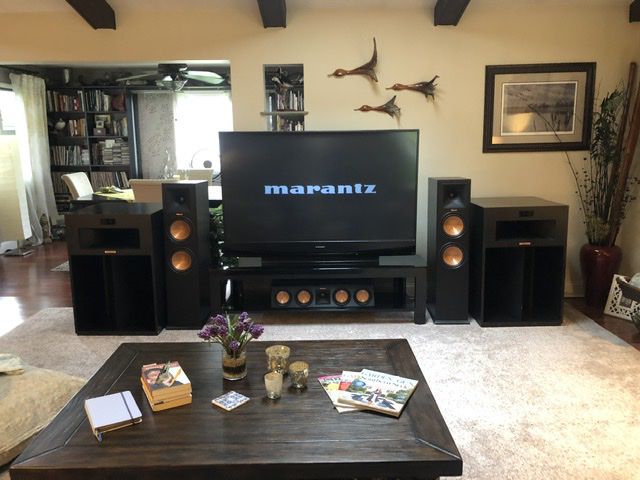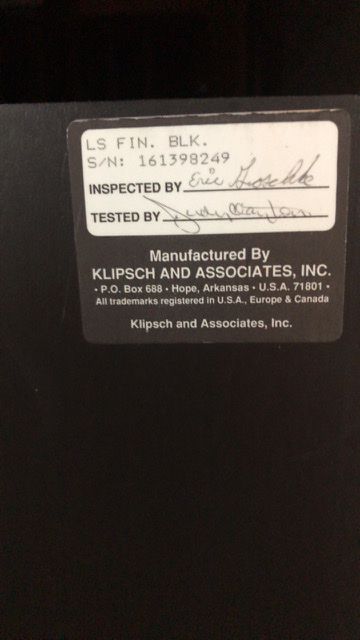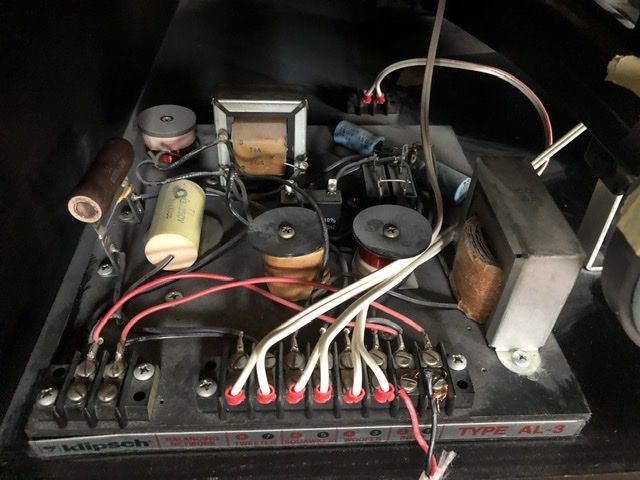-
Posts
1364 -
Joined
-
Last visited
-
Days Won
1
Content Type
Forums
Events
Gallery
Everything posted by Alexander
-
Not sure how it happened but I believe the pics in my previous post belong to the OP
-
Usual they will either be good or open, iirc you should see ~6-8ohms. If one of the tweeters sound OK swap out the two and see if it follows the tweeter or stays with the cabinet. You may need to freshen up or update the crossovers.
-
You can disconnect just one of the wires (either one) on the tweeter for measuring resistance with a DVM. Also stuffing a towel into the mid horn is another way to help listen to the tweeter by itself
-
With your footprint limitations in mind: Another two models series to add to the confusion would be the CF3 & 4's and KLF-20 & 30's. The CF's are highly sought after and can pull a premium price but you never know what might show up. The KLF's are sometimes looked upon as a black sheep by some. But in my case they are my primary's and the F2's sit on stand-by duty. The price of the KLF's have been going up in recent past but there are still deals to be found if you take your time. ~2 years ago I payed $1000 for a pair of Med Oak KLF-30's off of CL from the original owner that were mint and even came with the original boxes. At the time the average price for these were ~$800. Was a 5 hour round trip to Atlanta (man what a crazy place that was). BTW, most of the eBay listings for used Klipsch models we are all talking about have dreamer prices. As an after thought: Another sleeper is the Tangent 400, 500, 4000 & 5000”s. The 400/500's are for the most part a cheap(er) Heresy while the 4000/5000's would be thought as a forte I in a larger (taller) cabinet. When these show up from time to time they are usually pretty cheep, my T5000's cost $230! But also be aware they will most likely need some kind of attention over 50% of the time.
-
Thought I read somewhere the CW-IV mid horn is a CF3/4 horn with mumps.
-
Welcome to the Klipsch family.
-
Would like to clarify an assumption - is the k52 & k52h in fact are one and the same driver less the horn mounting method?
-
Maybe I should have worded it this way – the company owning the two usually has a higher price point on the Marantz line when comparing a Denon similar model.
-
On the chance you did not know - Marantz & Denon are owned my the same company. The Marantz line is considered the higher end of the two and typically offer more features but the core electronics are for the most part the same for each others sister models.
-
What are you going to be using for your vibration absorbent on the drivers if you don't mined me asking?
-
Congrats! You will be moving up several steps in the Klipsch food chain.
-
14/4 or 14/2 for a pair of rock speakers
Alexander replied to Lafalot's topic in General Klipsch Info
You may want to read up on speaker wire, a 75ft run is a lot. https://en.wikipedia.org/wiki/Speaker_wire#Resistance Keep in mind (as mentioned in the link above) if you use CCA (copper clad aluminum) that you should up the wire gauge by two, in other words go from say 14awg to 12awg for an exact load capability. Maximum wire lengths for two conductor copper wire[4] Wire size 2 Ω load 4 Ω load 6 Ω load 8 Ω load 22 AWG (0.326 mm2) 3 ft (0.9 m) 6 ft (1.8 m) 9 ft (2.7 m) 12 ft (3.6 m) 20 AWG (0.518 mm2) 5 ft (1.5 m) 10 ft (3 m) 15 ft (4.5 m) 20 ft (6 m) 18 AWG (0.823 mm2) 8 ft (2.4 m) 16 ft (4.9 m) 24 ft (7.3 m) 32 ft (9.7 m) 16 AWG (1.31 mm2) 12 ft (3.6 m) 24 ft (7.3 m) 36 ft (11 m) 48 ft (15 m) 14 AWG (2.08 mm2) 20 ft (6.1 m) 40 ft (12 m) 60 ft (18 m)* 80 ft (24 m)* 12 AWG (3.31 mm2) 30 ft (9.1 m) 60 ft (18 m)* 90 ft (27 m)* 120 ft (36 m)* 10 AWG (5.26 mm2) 50 ft (15 m) 100 ft (30 m)* 150 ft (46 m)* 200 ft (61 m)* -
14/4 or 14/2 for a pair of rock speakers
Alexander replied to Lafalot's topic in General Klipsch Info
How long will your runs be? I would say 14/4 & double up the wire pairs for each speaker. -
IMO, one should first get familiar with a set of speakers before doing anything to them.
-
K75K with Ti's - two .zma examples forte II K31K four .zma examples from klf-30 K61K - two .zma examples forte II k75-ti-b.zma k75-ti-a.zma k31k-a.zma k31k-b.zma k31k-c.zma k31k-d.zma k61ka.zma k61kb.zma
-
Actually, this was a test run using the k61's since they were already out of the cabs. The real plan was the klf-30's, and yes they are very thin compared to the k61 horn. The rope caulk is something I had not thought of, thanks
-
From Wikipedia - Here is a small portion of the link given above Wire material Use of copper or copper-clad aluminum (CCA) is more or less universal for speaker wire. Copper has low resistance compared to most other suitable materials. CCA is cheaper and lighter, at the expense of somewhat higher resistance (about the same as copper two AWG numbers up). Copper and aluminum both oxidize, but oxides of copper are conductive, while those of aluminum are insulating. Also offered is Oxygen-free Copper (OFC), sold in several grades. The various grades are marketed as having better conductivity and durability, but they have no significant benefit in audio applications.[4] Commonly available C11000 Electrolytic-Tough-Pitch (ETP) copper wire is identical to higher-cost C10200 Oxygen-Free (OF) copper wire in speaker cable applications. Much more expensive C10100, a highly refined copper with silver impurities removed and oxygen reduced to 0.0005 percent, has only a one percent increase in conductivity rating, insignificant in audio applications.[ As for OFC, I personally do not go that far. Years ago when it was the “new thing” I found no difference over regular copper wire, maybe my gear and/or ears were not good enough to tell. We won't go down the rabbit hole with the skin effect.
-
Have seen a few posts that they dampened their mid horns and wonder how many found a noticeable difference doing so. Just thinking I may do this to a set of k61's while they are out replacing a dead diaphragm (will replace both). Have read a few different methods, dynomat, silicon even automotive spray sound deadener. The spray on sound deadener looks to the be easiest but silicon is a choice for me too. The dynomat would be too much of a pain with all that ribbing and then there is the cost of it too. Are there any other ways some of you used that gave you good results? So, for those that have done this what is your verdict? Would you say it was worth it??






